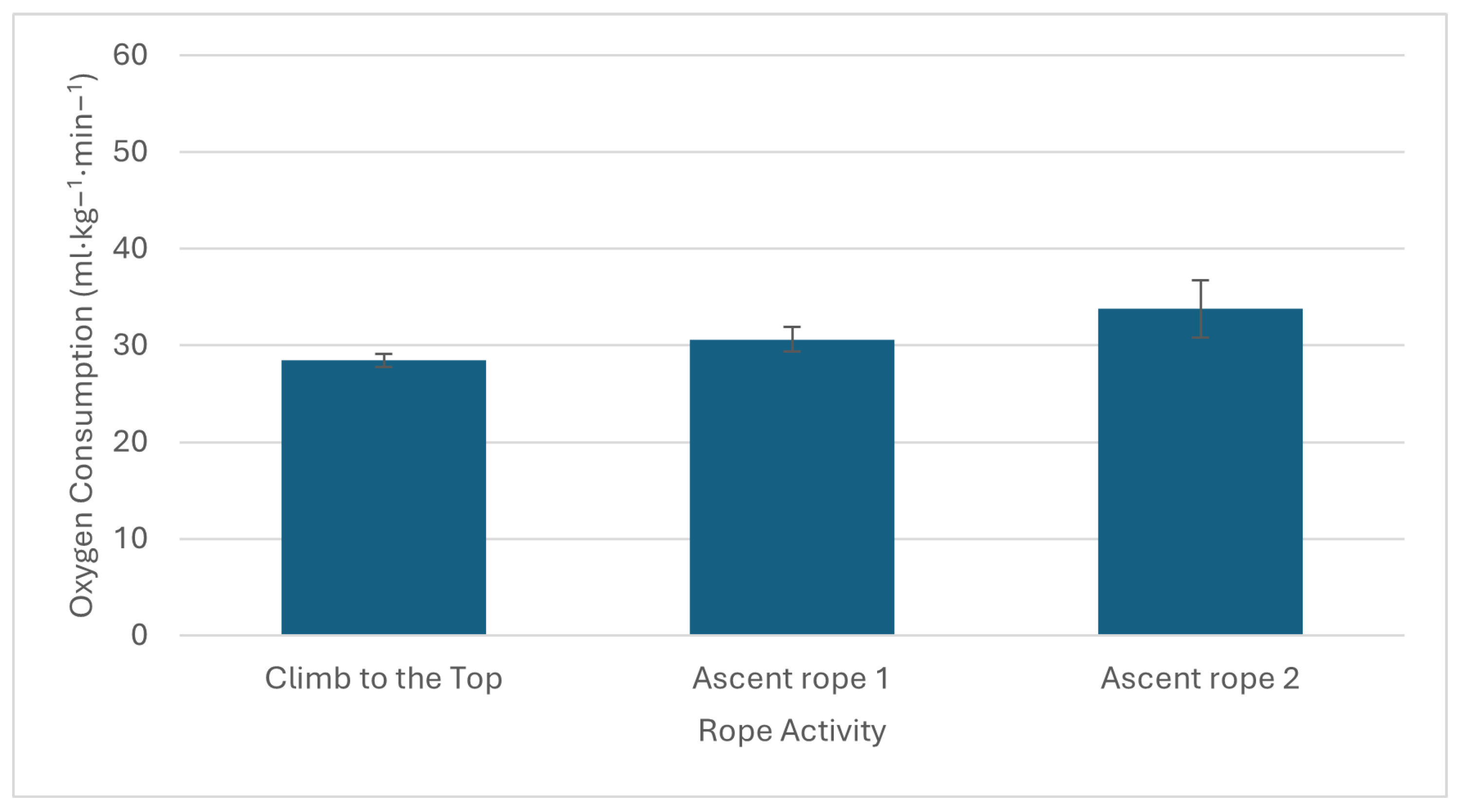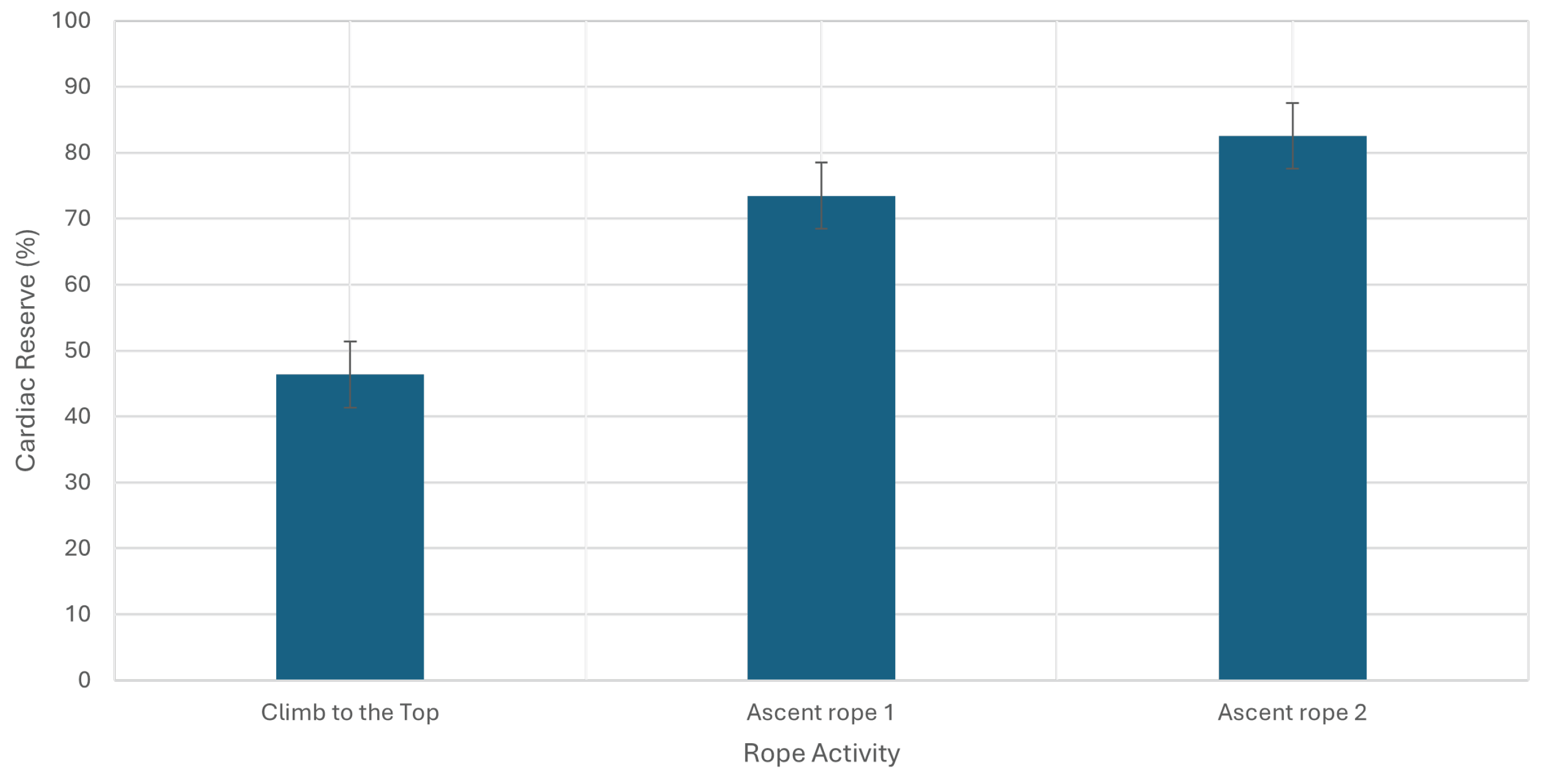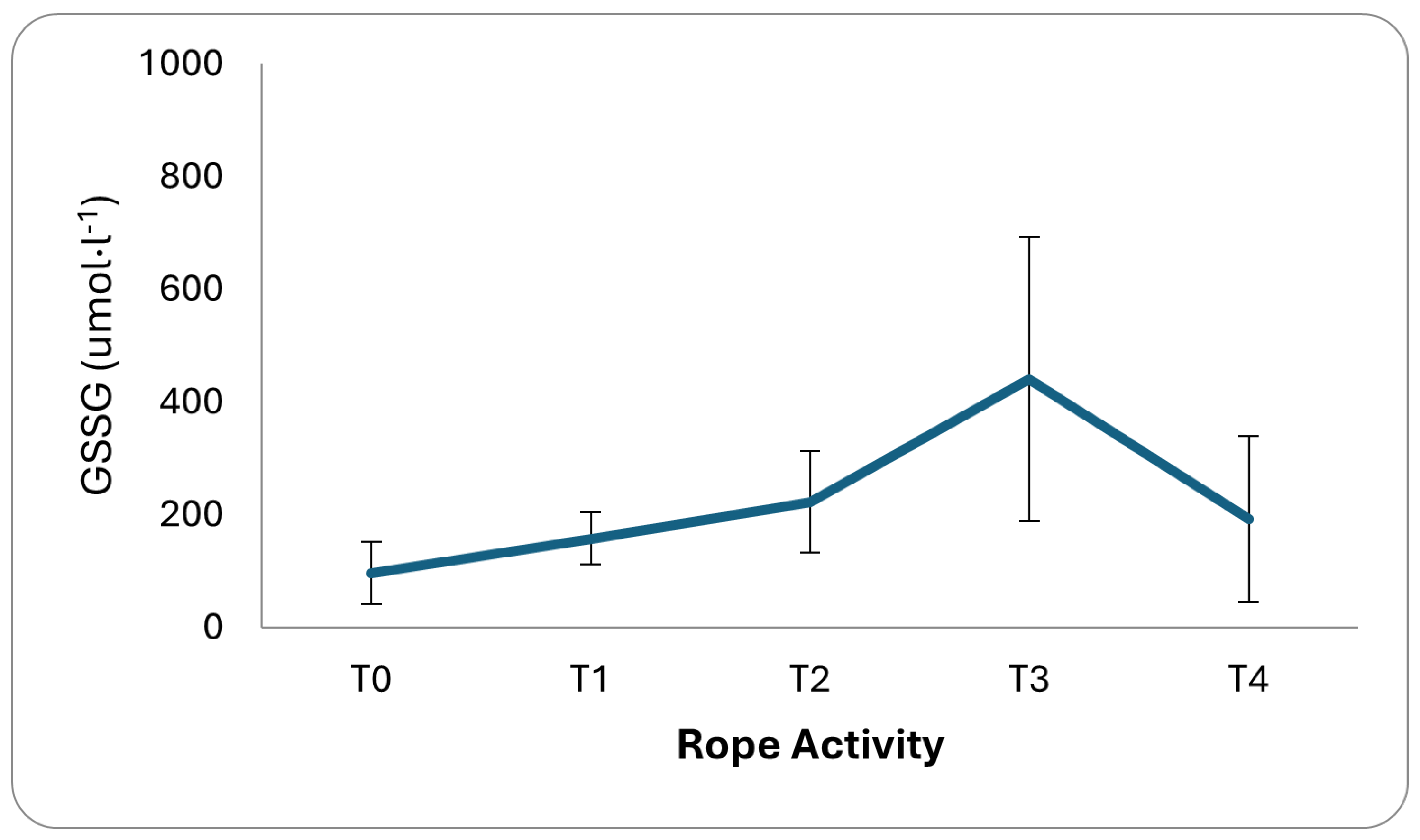Italian Canyoning Guides: Physiological Profile and Cardiometabolic Demand during Rope Activities
Abstract
1. Introduction
2. Materials and Methods
3. Results
4. Discussion
5. Conclusions
Author Contributions
Funding
Institutional Review Board Statement
Informed Consent Statement
Data Availability Statement
Acknowledgments
Conflicts of Interest
Abbreviations
| ENGC | National Canyoning Guides Organization |
| BMI | Body Mass Index |
| FM | Fat Mass |
| VSR | V-Sit and Reach |
| SBS | Stork Balance Stand |
| SBSDL | Stork Balance Stand Dominant Leg |
| SBSNDL | Stork Balance Stand Non-Dominant Leg |
| RT | Ruler Test |
| RTDH | Ruler Test Dominant Hand |
| RTNDH | Ruler Test Non-Dominant Hand |
| SJ | Squat Jump |
| PUp | Push-Up |
| RD | Ruffier-Dickson |
| ROS | Reactive Oxygen Species |
| GSSG | Glutathione Disulfide |
| GSS | Oxidized Glutathione |
| GSS+GSH | Glutathione |
| 8-OHdG | 8-Hydroxy Deoxyguanosine |
References
- Eigenschenk, B.; Thomann, A.; McClure, M.; Davies, L.; Gregory, M.; Dettweiler, U.; Inglés, E. Benefits of outdoor sports for society. A systematic literature review and reflections on evidence. Int. J. Environ. Res. Public Health 2019, 16, 937. [Google Scholar] [CrossRef] [PubMed]
- Rodio, A.; Fattorini, L. Downhill walking to improve lower limb strength in healthy young adults. Eur. J. Sport Sci. 2014, 14, 806–812. [Google Scholar] [CrossRef] [PubMed]
- Diotaiuti, P.; Corrado, S.; Mancone, S.; Falese, L. Resilience in the endurance runner: The role of self-regulatory modes and basic psychological needs. Front. Psychol. 2021, 11, 1–9. [Google Scholar] [CrossRef] [PubMed]
- Rodio, A.; Misiti, F.; Zagaglia, A.; Stabile, L.; Buonanno, G.; Fattorini, L. Airborne Ultrafine Particle and Acute Physiological Effects during Maximal Aerobic Power Test. Aerosol Air Qual. Res. 2022, 22, 220029. [Google Scholar] [CrossRef]
- Gonçalves, E.; Guerra, R.; Figueiredo, V. Green Tourism and Sustainability: The Paiva Walkways Case in the Post-Pandemic Period (Portugal). Sustainability 2023, 15, 13969. [Google Scholar] [CrossRef]
- Nielsen, H. Outdoor Recreation: Physiological and Psychological Effects on Health; BoD–Books on Demand: Norderstedt, Germany, 2021. [Google Scholar]
- Perrin, C. Implications of the provision of canyoning within the structure of tourism services. Téoros Rev. Rech. Tour. 2005, 24, 45–54. [Google Scholar] [CrossRef]
- Akhoundogli, M.; Buckley, R. Outdoor tourism to escape social surveillance: Health gains but sustainability costs. J. Ecotourism 2023, 22, 4–24. [Google Scholar] [CrossRef]
- Fattorini, L.; Pittiglio, G.; Federico, B.; Pallicca, A.; Bernardi, M.; Rodio, A. Workload comparison between hiking and indoor physical activity. J. Strength Cond. Res. 2012, 26, 2883–2889. [Google Scholar] [CrossRef] [PubMed]
- Rodio, A.; Fattorini, L.; Rosponi, A.; Quattrini, F.; Marchetti, M. Physiological adaptation in noncompetitive rock climbers: Good for aerobic fitness? J. Strength Cond. Res. 2008, 22, 359–364. [Google Scholar] [CrossRef] [PubMed]
- Petrone, P.; Espinoza-Villalobos, S.; Baltazar, G.; Søreide, K.; Stright, A.; Brathwaite, C.; D’Andrea, K. Fatal and non-fatal injuries due to suspension trauma syndrome: A systematic review of definition, pathophysiology, and management controversies. World J. Emerg. Med. 2021, 12, 253. [Google Scholar] [CrossRef] [PubMed]
- Hardiman, N.; Burgin, S. Canyoning adventure recreation in the Blue Mountains World Heritage Area (Australia): The canyoners and canyoning trends over the last decade. Tour. Manag. 2011, 32, 1324–1331. [Google Scholar] [CrossRef]
- Ainsworth, B.; Haskell, W.; Leon, A.; Jacobs, D., Jr.; Montoye, H.; Sallis, J.; Paffenbarger, R., Jr. Compendium of physical activities: Classification of energy costs of human physical activities. Med. Sci. Sport. Exerc. 1993, 25, 71–80. [Google Scholar] [CrossRef] [PubMed]
- Williams, S.; Graham, T.; Baker, B. Evaluating outdoor experiential training for leadership and team building. J. Manag. Dev. 2003, 22, 45–59. [Google Scholar] [CrossRef]
- Felici, F.; Rosponi, A.; Sbriccoli, P.; Scarcia, M.; Bazzucchi, I.; Iannattone, M. Effect of human exposure to altitude on muscle endurance during isometric contractions. Eur. J. Appl. Physiol. 2001, 85, 507–512. [Google Scholar] [CrossRef] [PubMed]
- Loureiro, A.; Pereira, J.; Martins, S.; Brandao, A. Investigation into the dynamics of internal and external intensities during a tourist canyoning season. J. Phys. Educ. Sport 2023, 23, 3127–3141. [Google Scholar]
- Ernstbrunner, L.; Schulz, E.; Ernstbrunner, M.; Hoffelner, T.; Freude, T.; Resch, H.; Haas, M. A prospective injury surveillance study in canyoning. Injury 2018, 49, 792–797. [Google Scholar] [CrossRef] [PubMed]
- Ramos, J.; Pérez, J.; Paniagua, S.; Arroyo, C. Analysis of the economic impact and perception of canyoning users in Extremadura. A gender approach. E-Motion Rev. Educ. Mot. Investig. 2023, 20, 27–42. [Google Scholar] [CrossRef]
- Brandão, A.; Marques, A.; Pereira, J.; Coelho, E.; Quaresma, L. Development of a tool to analyze risk perception in canyoning using a delphi technique. J. Phys. Educ. Sport 2018, 18, 1028–1034. [Google Scholar]
- Strapazzon, G.; Reisten, O.; Argenone, F.; Zafren, K.; Zen-Ruffinen, G.; Larsen, G.; Soteras, I. International Commission for Mountain Emergency Medicine Consensus Guidelines for on-site management and transport of patients in canyoning incidents. Wilderness Environ. Med. 2018, 29, 252–265. [Google Scholar] [CrossRef] [PubMed]
- Federici, A. Enjoying natural environments safely: Sports, adventure, risk and safeguarding health. J. Phys. Educ. Sport 2021, 21, 520–525. [Google Scholar]
- Nuttall, F. Body mass index: Obesity, BMI, and health: A critical review. Nutr. Today 2015, 50, 117–128. [Google Scholar] [CrossRef] [PubMed]
- Katch, F.; McArdle, W. Prediction of body density from simple anthropometric measurements in college-age men and women. Hum. Biol. 1973, 45, 445–455. [Google Scholar]
- Cuberek, R.; Machová, I.; Lipenská, M. Reliability of V sit-and-reach test used for flexibility self-assessment in females. Acta Gymnica. 2013, 43, 35–39. [Google Scholar] [CrossRef]
- Kranti Panta, B. A study to associate the Flamingo Test and the Stork Test in measuring static balance on healthy adults. Foot Ankle Online J. 2015, 8, 4. [Google Scholar]
- Schooten, K.; Duran, L.; Visschedijk, M.; Pijnappels, M.; Lord, S.; Richardson, J.; Delbaere, K. Catch the ruler: Concurrent validity and test–retest reliability of the ReacStick measures of reaction time and inhibitory executive function in older people. Aging Clin. Exp. Res. 2019, 31, 1147–1154. [Google Scholar] [CrossRef]
- Carissimo, C.; Cerro, G.; Di Libero, T.; Ferrigno, L.; Marino, A.; Rodio, A. Objective evaluation of coordinative abilities and training effectiveness in sports scenarios: An automated measurement protocol. IEEE Access 2023, 11, 76996–77008. [Google Scholar] [CrossRef]
- McMahon, J.; Lake, J.; Suchomel, T. Vertical jump testing. In Performance Assessment in Strength and Conditioning; Routledge: London, UK, 2018; pp. 96–116. [Google Scholar]
- Saint Romain, B.; Mahar, M. Norm-referenced and criterion-referenced reliability of the push-up and modified pull-up. Meas. Phys. Educ. Exerc. Sci. 2001, 5, 67–80. [Google Scholar] [CrossRef]
- Zanevskyy, I.; Janiszewska, R.; Zanevska, L. Validity of Ruffier test in evaluation of resistance to the physical effort. J. Test. Eval. 2017, 45, 2193–2199. [Google Scholar] [CrossRef]
- Mariano, A.; Bigioni, I.; Misiti, F.; Fattorini, L.; Scotto d’Abusco, A.; Rodio, A. The nutraceuticals as modern key to achieve erythrocyte oxidative stress fighting in osteoarthritis. Curr. Issues Mol. Biol. 2022, 44, 3481–3495. [Google Scholar] [PubMed]
- Mello, L. Potential contribution of ELISA and LFI assays to assessment of the oxidative stress condition based on 8-oxodG biomarker. Anal. Biochem. 2021, 628, 114215. [Google Scholar] [CrossRef]
- Ministro della Salute. Ministero della Salute. Medicina 2022, 50, 2025. [Google Scholar]
- American College of Sports Medicine. ACSM’s Guidelines for Exercise Testing and Prescriptio; Lippincott Williams & Wilkins: Philadelphia, PA, USA, 2013. [Google Scholar]
- Knudson, D. Warm-up and Flexibility. In Conditioning For Strength And Human Performance; Routledge: London, UK, 2018; pp. 212–231. [Google Scholar]
- Wolf, J.; Cameron, K.; Owens, B. Impact of joint laxity and hypermobility on the musculoskeletal system. JAAOS J. Am. Acad. Orthop. Surg. 2011, 19, 463–471. [Google Scholar] [CrossRef] [PubMed]
- Russek, L.; Errico, D. Prevalence, injury rate and, symptom frequency in generalized joint laxity and joint hypermobility syndrome in a “healthy” college population. Clin. Rheumatol. 2016, 35, 1029–1039. [Google Scholar] [CrossRef]
- Terblanche, H. The Influence of a Intense Training Program on Hypermobility and Correlation between Hypermobility and Incidence of Injury. Master’s Thesis, University of Pretoria, Pretoria, South Africa, 2015. [Google Scholar]
- Norton, K.; Norton, L.; Sadgrove, D. Position statement on physical activity and exercise intensity terminology. J. Sci. Med. Sport 2010, 13, 496–502. [Google Scholar] [CrossRef] [PubMed]
- Heyward, H. The Physical Fitness Specialist Certification Manual, The Cooper Institute for Aerobics Research, Dallas TX, revised 1997 printed in Advance Fitness Assessment & Exercise Prescription. Adv. Fit. Assess. Exerc. Prescr. 1998, 6, 48. [Google Scholar]



| Male | Female | |
|---|---|---|
| Year experience (y) | 8.1 ± 7.34 | 7.0 ± 3.92 |
| Age (y) | 43.4 ± 11.92 | 40.0 ± 6.38 |
| Weight (kg) | 79.5 ± 7.63 | 59.8 ± 7.41 |
| Height (cm) | 179.6 ± 5.36 | 168.0 ± 1.41 |
| BMI (kg/m) | 24.9 ± 2.57 | 21.1 ± 2.34 |
| FM (%) | 18.4 ± 5.65 | 14.0 ± 1.92 |
| Mean ± SD | Level | W | p | |
|---|---|---|---|---|
| VSR (cm) | 19.3 ± 13.04 | Above average | 0.978 | 0.936 |
| SBSDL (s) | 5.2 ± 2.97 | Low | 0.885 | 0.039 |
| SBSNDL (s) | 3.6 * ± 1.80 | Low | 0.853 | 0.012 |
| RTDH (ms) | 202 ± 45.60 | Good | 0.966 | 0.742 |
| RTNDH (ms) | 168.1 * ± 34.09 | Excellent | 0.947 | 0.415 |
| SJ (cm) | 27.3 ± 5.98 | Very good | 0.929 | 0.21 |
| PUp (rep) | 21.9 ± 6.98 | Very good | 0.968 | 0.79 |
| RD Index (ua) | 10.6 ± 6.63 | Very low | 0.967 | 0.771 |
Disclaimer/Publisher’s Note: The statements, opinions and data contained in all publications are solely those of the individual author(s) and contributor(s) and not of MDPI and/or the editor(s). MDPI and/or the editor(s) disclaim responsibility for any injury to people or property resulting from any ideas, methods, instructions or products referred to in the content. |
© 2024 by the authors. Licensee MDPI, Basel, Switzerland. This article is an open access article distributed under the terms and conditions of the Creative Commons Attribution (CC BY) license (https://creativecommons.org/licenses/by/4.0/).
Share and Cite
Di Libero, T.; Falese, L.; Corrado, S.; Tosti, B.; Diotaiuti, P.; Rodio, A. Italian Canyoning Guides: Physiological Profile and Cardiometabolic Demand during Rope Activities. Sports 2024, 12, 129. https://doi.org/10.3390/sports12050129
Di Libero T, Falese L, Corrado S, Tosti B, Diotaiuti P, Rodio A. Italian Canyoning Guides: Physiological Profile and Cardiometabolic Demand during Rope Activities. Sports. 2024; 12(5):129. https://doi.org/10.3390/sports12050129
Chicago/Turabian StyleDi Libero, Tommaso, Lavinia Falese, Stefano Corrado, Beatrice Tosti, Pierluigi Diotaiuti, and Angelo Rodio. 2024. "Italian Canyoning Guides: Physiological Profile and Cardiometabolic Demand during Rope Activities" Sports 12, no. 5: 129. https://doi.org/10.3390/sports12050129
APA StyleDi Libero, T., Falese, L., Corrado, S., Tosti, B., Diotaiuti, P., & Rodio, A. (2024). Italian Canyoning Guides: Physiological Profile and Cardiometabolic Demand during Rope Activities. Sports, 12(5), 129. https://doi.org/10.3390/sports12050129







